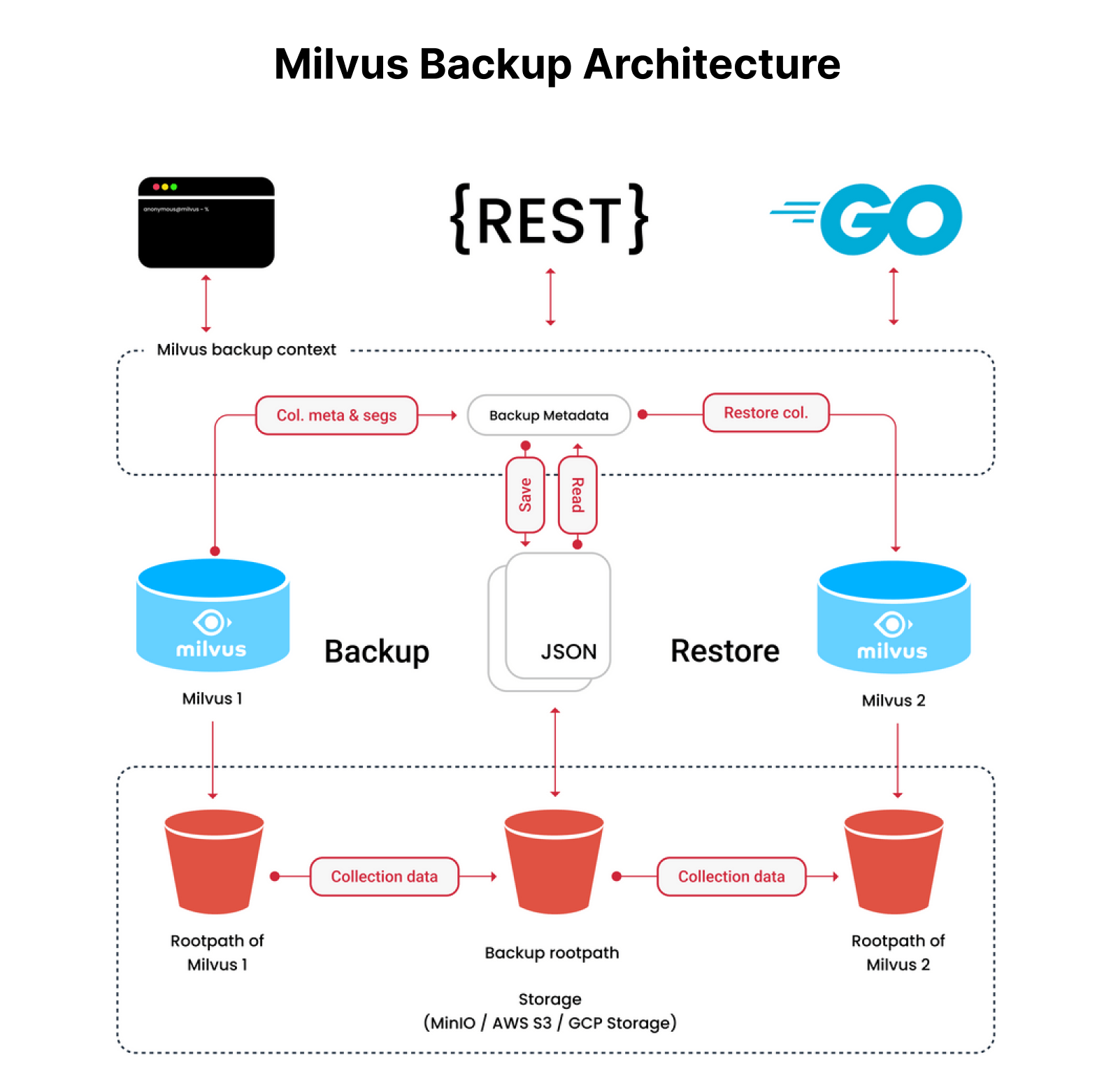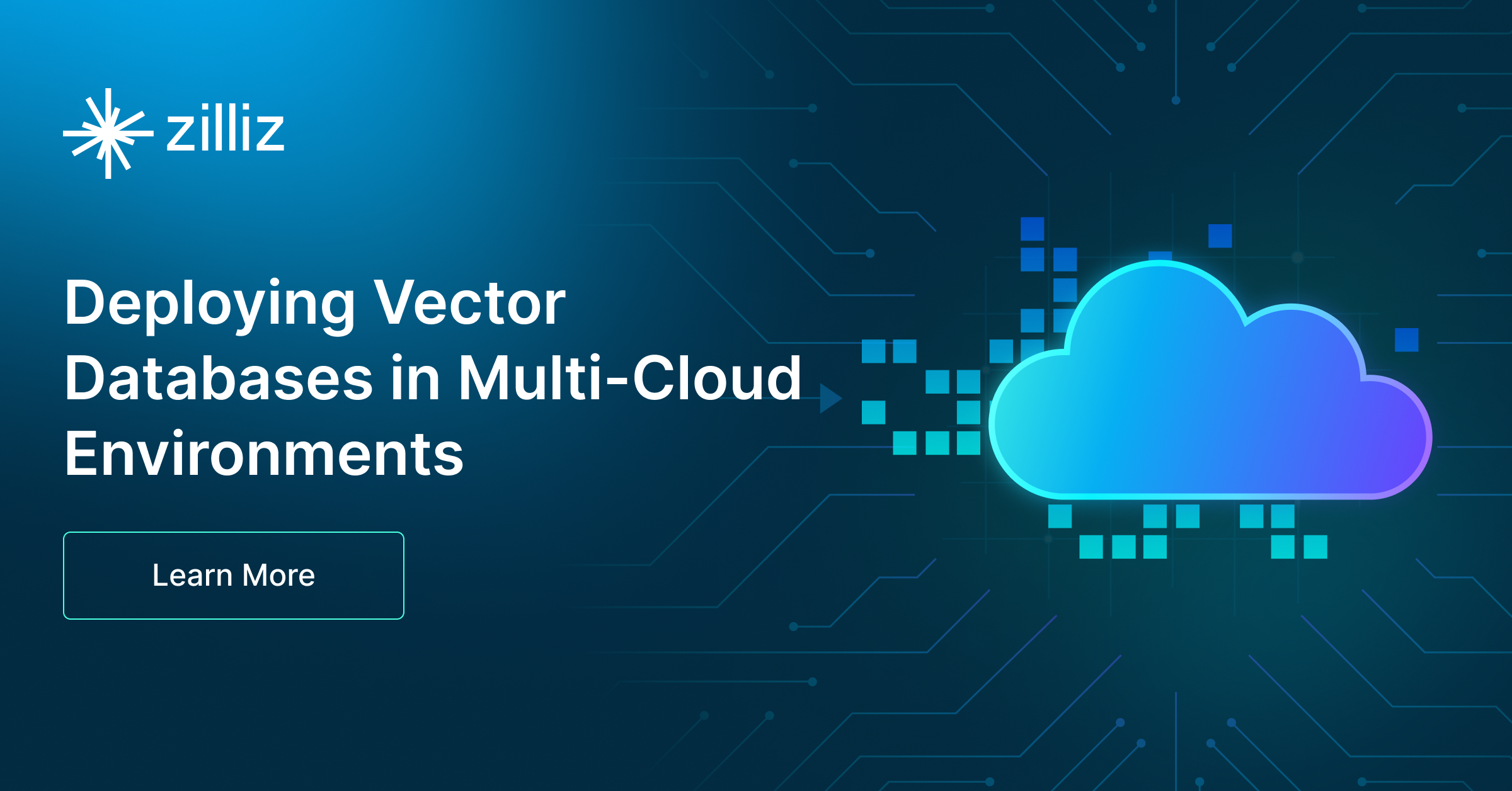Safeguard Data Integrity: Backup and Recovery in Vector Databases
This blog explores data backup and recovery in vectorDBs, their challenges, various methods, and specialized tools to fortify the security of your data assets.
Read the entire series
- Safeguard Data Integrity: Backup and Recovery in Vector Databases
- Integrating Vector Databases with Cloud Computing: A Strategic Solution to Modern Data Challenges
- Maintaining Data Integrity in Vector Databases
- Deploying Vector Databases in Multi-Cloud Environments
- Ensuring High Availability of Vector Databases
- Scaling Vector Databases to Meet Enterprise Demands
- Getting Started with Voyager: Spotify's Nearest-Neighbor Search Library
In today's data-driven world, the exponential surge in unstructured data, such as images, videos, texts, and audio, is reshaping how organizations approach data management. Many are turning to vector databases to efficiently store, retrieve, and analyze this vast volume of data, unlocking higher business value.
As organizations grapple with the challenges posed by escalating volumes of intricate unstructured data, the need for robust backup and recovery strategies becomes increasingly evident. This blog explores data backup and recovery in vector databases, their challenges, various methods, and specialized tools to fortify the security of your invaluable data assets.
What Is Backup and Recovery?
Data backup duplicates and securely stores data separately from the original source to mitigate loss or damage in disasters such as hardware failures, human errors, cyberattacks, natural disasters, or software malfunctions. Data recovery restores data from backups after it has been lost, corrupted, or accidentally deleted. It aims to minimize downtime and restore normal operations quickly.
Both backup and recovery are essential components of data protection strategies. They safeguard against data loss and enable organizations to maintain the integrity and availability of their critical information assets.
Why Backup and Recovery Matters for Vector Databases
Vector databases represent a paradigm shift in data management, purposely crafted to navigate the mazy pathways of intricate unstructured data in modern applications such as retrieval augmented generation (RAG), machine learning, chatbots, and recommendation systems. With the exponential growth of unstructured data, many vector databases like Milvus have enhanced scaling capabilities, accommodating tens of billions of vector points. However, the risk of data loss due to hardware failures, software anomalies, or human error poses a significant threat to services, user experiences, and organizational resilience in this data-rich landscape.
Hardware Failures: From manufacturing defects to environmental factors like power fluctuations or harsh conditions, hardware failures significantly threaten data integrity.
Software Glitches: Vulnerabilities or crashes in software applications can lead to data loss or system downtime, with potential consequences as severe as complete OS crashes.
Human Error: Incorrect configurations or inadvertent deletions are recurrent triggers for hardware and software malfunctions, underscoring the need for robust backup mechanisms.
In light of these challenges, backup and recovery mechanisms are indispensable safeguards. The primary objective of backup is to engender a duplicate copy of data poised for retrieval in the event of a primary data failure. By preserving multiple copies of data, organizations fortify their resilience and mitigate the harmful impacts of data corruption or malicious intrusions.
Diverse Strategies for Vector Database Backup and Recovery
Various backup strategies exist for developers to survive unexpected disasters, each catering to different requirements. Popular strategies include:
Full Backup vs. Incremental Backup: Full backups offer complete restore points but can be time-consuming and resource-intensive. Incremental backups capture changes since the last backup and are ideal for databases with moderate change rates.
Hot Backup vs. Cold Backup: Hot backups minimize downtime by creating copies of databases while still active, while cold backups involve taking databases offline.
Selecting the optimal backup strategy requires an assessment of factors such as data types, volume, change frequencies, and urgency:
Frequency: How frequently does your vector database receive new data? Real-time applications may necessitate immediate backups, while others can tolerate longer intervals.
Volume: What data volume do you need to back up at once? Large data sets may require segmentation to prevent network congestion.
Urgency: How quickly do you need access to the latest data? Deciding the recovery speed is crucial to mitigating potential disruptions.
Type: What type of data are you backing up? Public, private, or proprietary data? Compliance regulations and security mandates often dictate specific backup protocols for sensitive data.
A resilient disaster recovery strategy can vary from simple backup methods to complex configurations tailored to meet precise recovery time objectives (RTO) and recovery point objectives (RPO). Key components of such plans encompass features like point-in-time recovery, ensuring uninterrupted availability through failover mechanisms, replication, and other pertinent strategies customized to suit your organization's requirements.
Once you've selected your preferred approach, it's crucial to thoroughly test the chosen strategies and solutions. Verify that the solution can successfully back up and restore data during disasters and ensure that applications can resume functionality after restoration.
Everyday Use Cases for Backup and Recovery
Backup and recovery solutions are crucial for safeguarding data and ensuring business continuity in various situations. Some everyday use cases for backup and recovery include:
Protection Against Data Loss: The primary use case for backup and recovery is to protect against data loss due to hardware failures, software bugs, human errors, or malicious attacks such as ransomware.
System Upgrades and Migrations: Backup and recovery are essential when performing system upgrades or migrations. They help you ensure that data can be safely transferred to new hardware or software environments without risk of loss or corruption.
Compliance and Legal Requirements: Many industries have strict compliance regulations regarding data retention and protection. Backup and recovery solutions help organizations meet these requirements by ensuring that data is securely backed up and can be retrieved as needed for audits, legal proceedings, or regulatory compliance.
Milvus Backup and Recovery
Milvus is an open-source vector database known for its scalability and reliability. It boasts a comprehensive array of backup and recovery options, encompassing full, incremental, and hot backup functionalities. Moreover, Milvus offers a robust backup and restore tool named Milvus Backup, designed to give users seamless control over backup processes through various user-friendly interfaces, including CLI, API, and gRPC-based Go modules.

Milvus Backup first retrieves metadata and segments from the original Milvus instance to form a backup. It proceeds to duplicate collection data from the source instance's root directory and stores it in the backup's root directory.
For restoration purposes, Milvus Backup establishes a new collection within the destination Milvus instance using metadata and segment details from the backup. Subsequently, it transfers the backed-up data from the backup's root directory to the root directory of the destination instance.
Refer to the backup and restoration documentation for detailed instructions on performing backup and restoration tasks in Milvus.
Zilliz Cloud Backup & Restore
The managed version of Milvus, Zilliz Cloud, also has a backup and restore feature for your Zilliz Cloud cluster to safeguard your data.
Snapshots serve as a backup copy of your managed cluster in Zilliz Cloud. They act as a reference point for creating new clusters or for data backup purposes. You can also set up automatic snapshots for your clusters for speedy recovery in unexpected incidents. We discussed in this article that regular snapshots minimize the risk of data loss and enable easy restoration to specific points in time, granting you greater control over your data backups.
Refer to the Backup & Restore documentation for Zilliz Cloud for detailed instructions on how to enable this feature.
Conclusion
Amidst the deluge of unstructured data today, safeguarding data integrity is unavoidable. For vector databases essential to modern AI applications, establishing resilient backup and recovery strategies is a safeguard against potential data mishaps. Organizations can bolster their data resilience and successfully navigate the uncertainties of an increasingly dynamic data environment by adhering to industry best practices, harnessing suitable tools, and embracing solutions like Milvus Backup.
- What Is Backup and Recovery?
- Why Backup and Recovery Matters for Vector Databases
- Diverse Strategies for Vector Database Backup and Recovery
- Everyday Use Cases for Backup and Recovery
- Milvus Backup and Recovery
- Zilliz Cloud Backup & Restore
- Conclusion
Content
Start Free, Scale Easily
Try the fully-managed vector database built for your GenAI applications.
Try Zilliz Cloud for FreeKeep Reading

Integrating Vector Databases with Cloud Computing: A Strategic Solution to Modern Data Challenges
Integrating vector databases and cloud computing creates a powerful infrastructure that significantly enhances the management of large-scale, complex data in AI and machine learning.

Deploying Vector Databases in Multi-Cloud Environments
Multi-cloud deployment has become increasingly popular for services looking for as much uptime as possible, with organizations leveraging multiple cloud providers to optimize performance, reliability, and cost-efficiency.

Getting Started with Voyager: Spotify's Nearest-Neighbor Search Library
Voyager: a new open-source library for fast nearest-neighbor searches. Voyager uses the HNSW algorithm, outperforming its previous library, Annoy.
